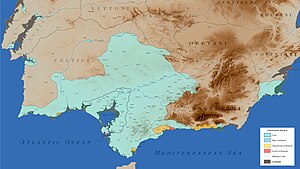

Tartessos (Spanish: Tartesos) is, as defined by archaeological discoveries,[1] a historical civilization settled in the southern Iberian Peninsula characterized by its mixture of local Paleohispanic and Phoenician traits. It had a writing system, identified as Tartessian, that includes some 97 inscriptions in a Tartessian language.
In the historical records, Tartessos (Greek: Ταρτησσός) appears as a semi-mythical or legendary harbor city and the surrounding culture on the south coast of the Iberian Peninsula (in modern Andalusia, Spain), at the mouth of the Guadalquivir.[2] It appears in sources from Greece and the Near East starting during the first millennium BC. Herodotus, for example, describes it as beyond the Pillars of Hercules.[3] Roman authors tend to echo the earlier Greek sources, but from around the end of the millennium there are indications that the name Tartessos had fallen out of use and the city may have been lost to flooding, although several authors attempt to identify it with cities of other names in the area.[4]
The Tartessians were rich in metals. In the fourth century BC the historian Ephorus describes "a very prosperous market called Tartessos, with much tin carried by river, as well as gold and copper from Celtic lands".[4] Trade in tin was very lucrative in the Bronze Age, since it is an essential component of bronze and is comparatively rare. Herodotus refers to a king of Tartessos, Arganthonios, presumably named for his wealth in silver. Herodotus also says that Arganthonios welcomed the first Greeks to reach Iberia, which was a ship carrying the Phocaeans from Asia Minor.
Pausanias wrote that Myron, the tyrant of Sicyon, built a treasury, which was called the treasury of the Sicyonians, to commemorate a victory in the chariot race at the Olympic games. In the treasury, he made two chambers with two different styles, one Doric and one Ionic, with bronze.[clarification needed] The Eleans said that the bronze was Tartessian.[5][6]
The people from Tartessos became important trading partners of the Phoenicians, whose presence in Iberia dates from the eighth century BC and who nearby built a harbor of their own, Gadir (Greek: Γάδειρα, Latin: Gades, present-day Cádiz).
- ^ Construyendo Tarteso
- ^ Brandherm, Dirk (1 September 2016). "6: Stelae, Funerary Practice, and Group Identities in the Bronze and Iron Ages of SW Iberia: A Moyenne Durée Perspective". In Koch, John T.; Barry Cunliffe (eds.). Celtic from the West 3, Atlantic Europe in the Metal Ages: questions of shared language. Oxbow Books. p. 179. ISBN 978-1-78570-230-3.
- ^ Herodotus, The History, i. 163; iv.152.
- ^ a b Cite error: The named reference
freemanwas invoked but never defined (see the help page). - ^ Pausanias, Description of Greece, 6.19.1
- ^ Pausanias, Description of Greece, 6.19.2